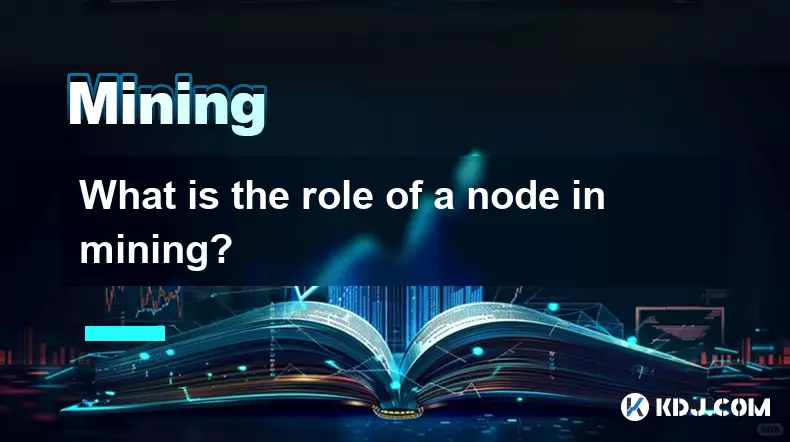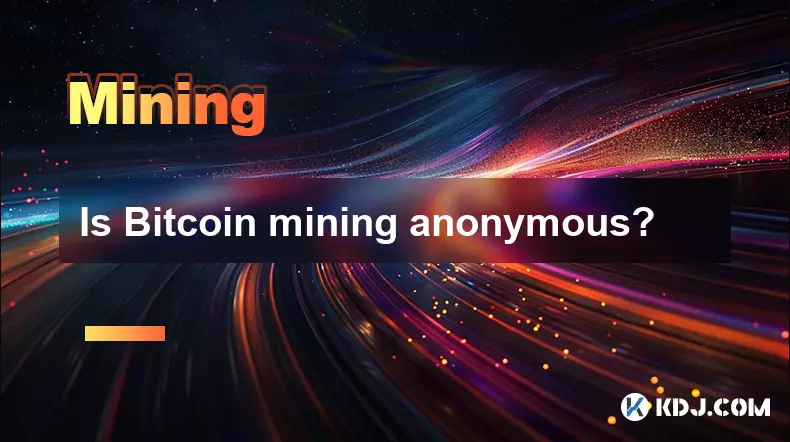-
 bitcoin
bitcoin $99177.955738 USD
-7.32% -
 ethereum
ethereum $3187.183061 USD
-12.38% -
 tether
tether $0.999809 USD
0.00% -
 xrp
xrp $2.117933 USD
-9.42% -
 bnb
bnb $906.710033 USD
-9.17% -
 solana
solana $149.367737 USD
-10.74% -
 usd-coin
usd-coin $0.999816 USD
0.01% -
 tron
tron $0.281498 USD
-0.38% -
 dogecoin
dogecoin $0.156292 USD
-8.00% -
 cardano
cardano $0.500744 USD
-10.19% -
 hyperliquid
hyperliquid $38.087358 USD
-4.58% -
 chainlink
chainlink $14.097831 USD
-8.54% -
 bitcoin-cash
bitcoin-cash $463.329916 USD
-9.22% -
 ethena-usde
ethena-usde $0.999078 USD
-0.01% -
 unus-sed-leo
unus-sed-leo $9.475862 USD
-0.79%
What is the role of a node in mining?
Nodes are essential to blockchain networks, maintaining decentralization, validating transactions, and ensuring security through distributed consensus.
Nov 05, 2025 at 07:44 pm

Understanding the Function of Nodes in Blockchain Networks
1. A node serves as a fundamental building block within a blockchain network, maintaining a copy of the entire ledger and ensuring data consistency across the system. Every participant running node software contributes to the decentralized nature of the cryptocurrency ecosystem.
2. Nodes validate transactions by checking digital signatures, confirming available balances, and enforcing consensus rules. This verification process prevents double-spending and maintains trust without relying on a central authority.
3. When new transactions are broadcast, nodes relay them across the network, forming a web of communication that ensures rapid dissemination. This peer-to-peer propagation strengthens network resilience and reduces bottlenecks.
4. Full nodes store the complete history of the blockchain, allowing independent verification of all activity since genesis. This capability empowers users to audit the network without depending on third-party services or assumptions.
5. By rejecting invalid blocks or rule-breaking behavior, nodes act as gatekeepers of protocol integrity. Their collective enforcement deters malicious actors and upholds the immutability of recorded data.
Nodes Enable Decentralized Consensus and Security
1. In proof-of-work systems like Bitcoin, miners rely on nodes to receive pending transactions and construct candidate blocks. Without nodes supplying verified transaction data, mining operations would lack input material for block creation.
2. After a miner solves the cryptographic puzzle, the resulting block is transmitted to neighboring nodes. These nodes independently verify the block’s validity before forwarding it further, creating a cascading validation mechanism.
3. The distributed nature of nodes prevents single points of failure. Even if some nodes go offline or attempt censorship, others continue propagating legitimate transactions and blocks.
4. Nodes participate in chain selection by accepting the longest valid chain according to consensus rules. This agreement across thousands of independent nodes reinforces the network's resistance to manipulation.
5. Malicious forks or altered histories are automatically rejected when they fail to meet validation criteria enforced by honest nodes. This automatic rejection preserves historical accuracy and user confidence.
The Relationship Between Mining and Node Operations
1. While all miners operate nodes, not all nodes are involved in mining. Regular full nodes contribute to security and decentralization without competing for block rewards.
2. Mining nodes combine standard node functions with specialized hardware designed to perform hash calculations at high speed. They extend regular node capabilities with computational power focused on solving proof-of-work challenges.
3. Mining profitability depends on accurate, up-to-date information about unconfirmed transactions—data provided directly by the node component of the mining setup.
4. A mining node must stay synchronized with the latest block to avoid wasting resources on obsolete chains. Timely updates from connected peers ensure efficient use of energy and computing capacity.
5. Independent operation of mining nodes prevents reliance on centralized pools or external block producers, enhancing personal control over reward distribution and transaction inclusion policies.
Frequently Asked Questions
Can a node mine cryptocurrency on its own?A standard full node cannot mine by default. To mine, additional software and hardware such as ASICs or GPUs must be integrated with the node to perform the necessary computational work for proof-of-work algorithms.
Do lightweight wallets interact with full nodes?Yes, lightweight or SPV wallets depend on full nodes to retrieve transaction data and verify inclusion in blocks. They query full nodes for relevant details while storing only partial blockchain information locally.
Is running a node required to send or receive cryptocurrency?No, users can transact without operating a node by using hosted wallets or third-party services. However, running a personal node increases privacy, security, and reduces dependency on external providers.
How does node distribution affect network health?Widespread geographic and operational diversity among nodes enhances censorship resistance and fault tolerance. Concentration of nodes in specific regions or under single entities introduces potential vulnerabilities to regulatory pressure or outages.
Disclaimer:info@kdj.com
The information provided is not trading advice. kdj.com does not assume any responsibility for any investments made based on the information provided in this article. Cryptocurrencies are highly volatile and it is highly recommended that you invest with caution after thorough research!
If you believe that the content used on this website infringes your copyright, please contact us immediately (info@kdj.com) and we will delete it promptly.
- XRP, Corporate Treasuries, and FX Hedging: A New Era for Global Finance?
- 2025-11-06 02:30:01
- ARC Token: India's Bold Step into Government Securities-Backed Digital Assets
- 2025-11-06 02:45:01
- Solana's Price Recovery: Harmonic Launch and Key Developments
- 2025-11-06 01:05:01
- Nebius Token Factory: Democratizing AI Deployment at Scale
- 2025-11-06 01:35:01
- Navigating the Crypto Landscape: Investment Opportunities in Web3, Bitcoin, and Ethereum
- 2025-11-06 00:55:01
- Solana Coin, Hype, and the Crypto Craze: What's the Deal?
- 2025-11-06 01:55:01
Related knowledge

What is the block reward in mining?
Nov 06,2025 at 12:35am
Understanding Block Rewards in Cryptocurrency Mining1. The block reward is the incentive miners receive for successfully validating and adding a new b...

Does an antivirus program affect mining?
Nov 05,2025 at 09:29pm
Understanding Decentralized Exchanges in the Crypto Ecosystem1. Decentralized exchanges (DEXs) operate without a central authority, allowing users to ...

What is the history of Bitcoin mining?
Nov 05,2025 at 08:15pm
Within the fast-moving world of cryptocurrency, new developments emerge daily, reshaping how investors, developers, and institutions interact with dig...

How is the energy consumption of mining justified?
Nov 05,2025 at 10:20pm
Energy Consumption in Cryptocurrency Mining1. The energy consumption associated with cryptocurrency mining has drawn significant attention from enviro...

What are the main components of a mining rig?
Nov 05,2025 at 08:09pm
Main Components of a Mining Rig1. A mining rig consists of several essential hardware components designed to solve complex cryptographic equations req...

Is Bitcoin mining anonymous?
Nov 06,2025 at 12:15am
Understanding Bitcoin Mining and Privacy1. Bitcoin mining is the process through which new transactions are verified and added to the blockchain. Mine...

What is the block reward in mining?
Nov 06,2025 at 12:35am
Understanding Block Rewards in Cryptocurrency Mining1. The block reward is the incentive miners receive for successfully validating and adding a new b...

Does an antivirus program affect mining?
Nov 05,2025 at 09:29pm
Understanding Decentralized Exchanges in the Crypto Ecosystem1. Decentralized exchanges (DEXs) operate without a central authority, allowing users to ...

What is the history of Bitcoin mining?
Nov 05,2025 at 08:15pm
Within the fast-moving world of cryptocurrency, new developments emerge daily, reshaping how investors, developers, and institutions interact with dig...

How is the energy consumption of mining justified?
Nov 05,2025 at 10:20pm
Energy Consumption in Cryptocurrency Mining1. The energy consumption associated with cryptocurrency mining has drawn significant attention from enviro...

What are the main components of a mining rig?
Nov 05,2025 at 08:09pm
Main Components of a Mining Rig1. A mining rig consists of several essential hardware components designed to solve complex cryptographic equations req...

Is Bitcoin mining anonymous?
Nov 06,2025 at 12:15am
Understanding Bitcoin Mining and Privacy1. Bitcoin mining is the process through which new transactions are verified and added to the blockchain. Mine...
See all articles










































































